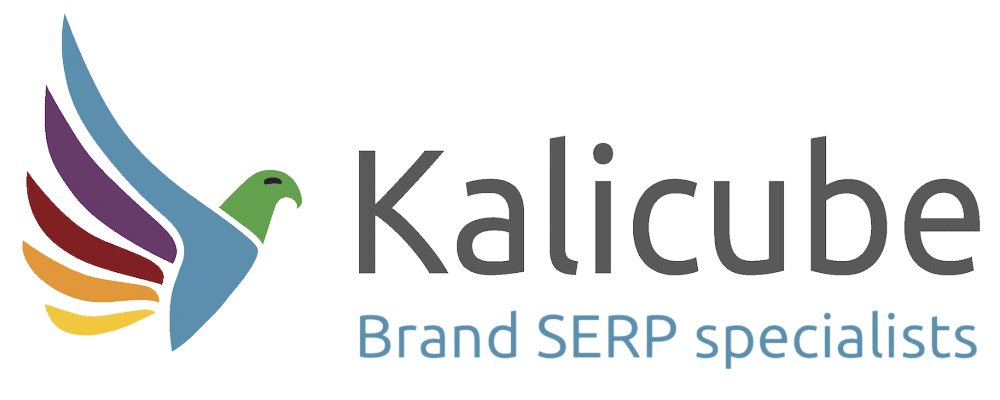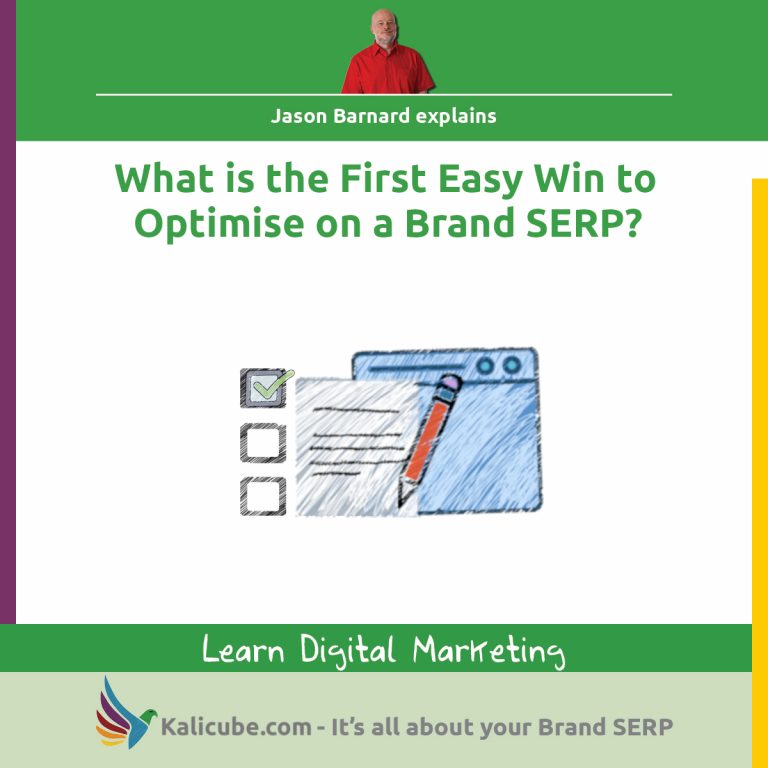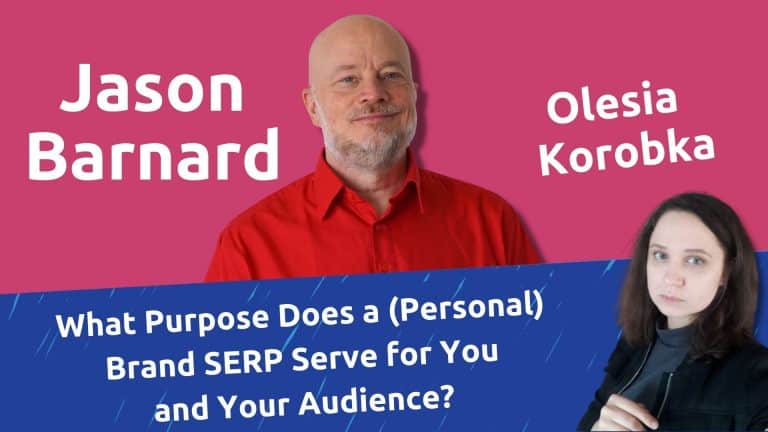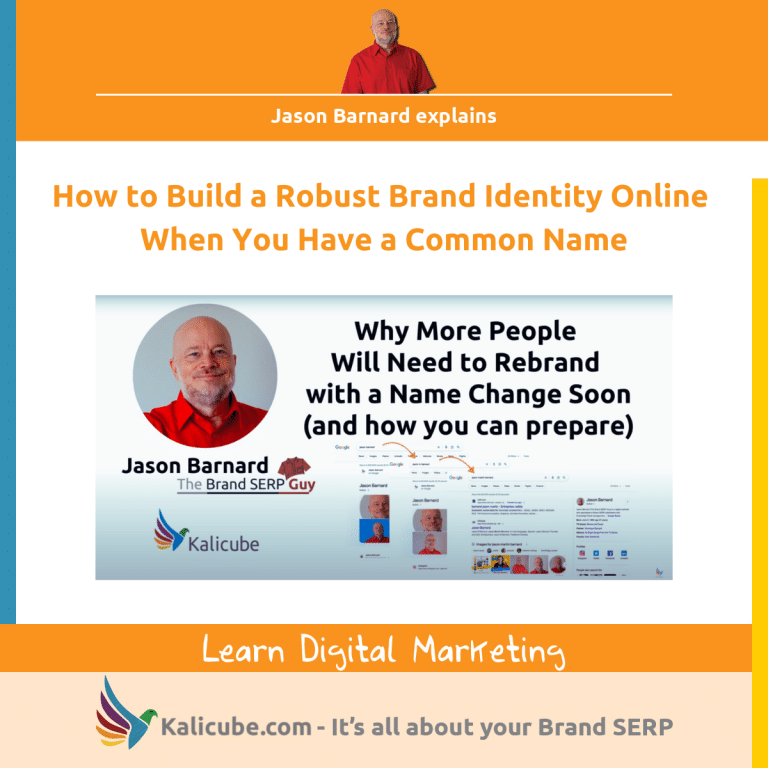Rebranding Your Company Name? Learn How to Keep Your Digital Brand Equity Strong!

In this case study, we will learn how to carry out a successful rebranding operation and make Google adapt to the new brand name in just 2 days!
Rebranding The Podcast
Jason Barnard’s podcast was rebranded from With Jason Barnard to Branded Search (and Beyond) with Jason Barnard. While this may seem like an easy task, if you’ve ever changed the name of a brand you’ll know that it is in fact a titanic task and remarkably complicated. What makes it so difficult is making Google “transfer” your gains achieved from the old brand name to the new one. That means that you want the SERP to reflect your new brand.
The Cost of Rebranding
According to the article “Your Business Name Stinks. Here’s How to Change It” written by Neil Parmar in 2014, a name rebranding operation costs between $100,000 and $1 million. However, it could cost much more if the rebranding doesn’t go as you expect.
I remember back in 2002 when Royal Mail changed its name to Consigna, and a year later changed it back again to Royal Mail.
The loss they suffered was monstrous. According to an article in the Independent, they recorded a £1.1bn loss for the year they traded under the name Consigna, in addition to 15,000 job losses.
This loss occurred in 2002 when the SERP was still made up of blue links. It’s a straightforward leap from there to imagine how much greater the organic traffic loss would have been nowadays.
Simply typing the query “Royal Mail” into Google brings up the brand all over the SERP (see image 0: Royal Mail). Nowadays, so many more things than in the Royal example can go wrong with a name rebranding operation, and all of those are the consequence of Google no longer understanding the branding.
In this blog post, we will focus mainly on the Knowledge Panel. We could surmise that if your Knowledge Panel is intact, then Google understands your rebranding.
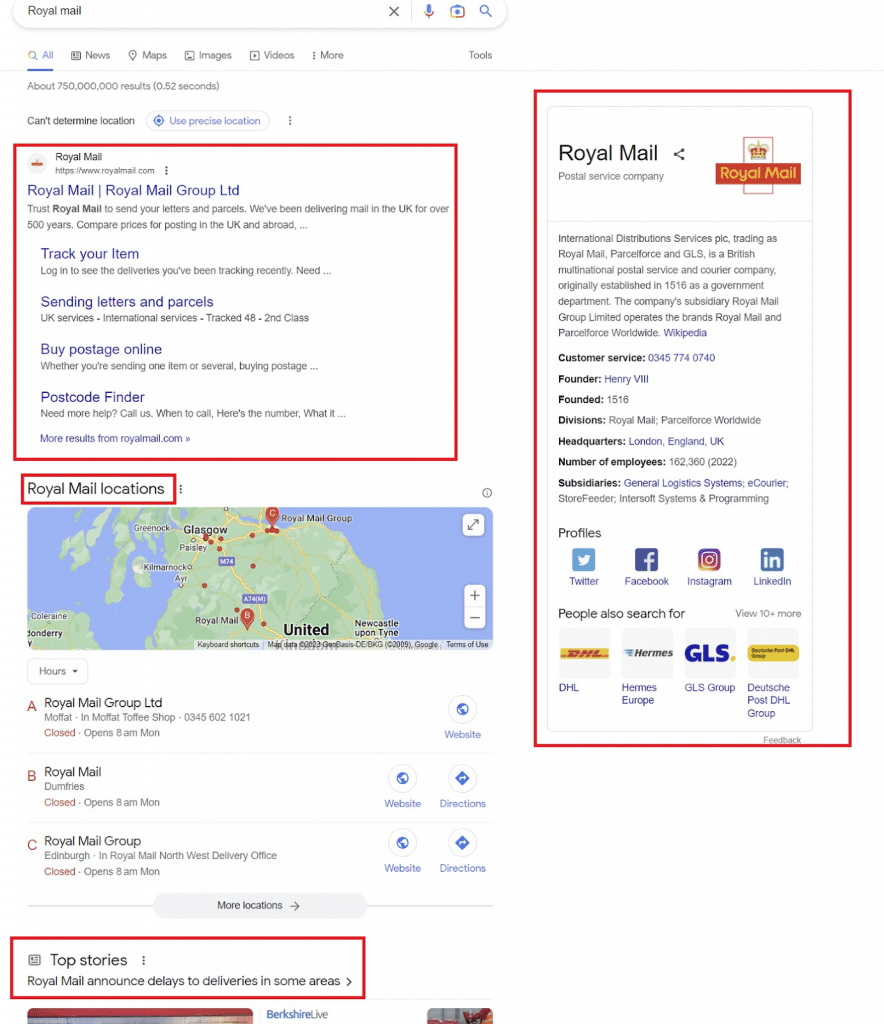
Introduction on Entity, Knowledge Graph and Knowledge Panel
Before digging deeper, let’s review what an entity is and what the knowledge graph is. This knowledge is essential to understanding the rest of the case study.
Entity
Let’s start with what an entity is. The easiest way to understand an entity is to think that an entity is people, places or things. If I ask a human: “do you know who Leonardo da Vinci is?”, most humans will immediately know who I’m talking about. A machine will translate Leonardo da Vinci as a number. So we could simplify the concept by saying an entity is a name that has a number assigned that the machine can read.
For a machine, it’s much easier to use a number. Think about where Leonardo da Vinci comes from – Italy. In English you would say ‘Italy’, in Italian ‘Italia’, in French ‘Italie’, and so on, but for the machine it will always be the same number.
The knowledge graph ID (machine readable number) for Leonardo da Vinci is /m/04lg6
Now that we know what an entity is, let’s look at what Google’s knowledge graph is.

Knowledge Graph
The knowledge graph is a large database that contains all connected entities and their connections. If we look back to our previous example, Leonarda da Vinci will be connected to Italy. The Knowledge Panel is the visual part of the knowledge graph.
Is/was Jason Barnard’s podcast an entity?
Yes, it is. The knowledge graph ID is /g/11frbnpw_7
Name rebranding is hard because if you don’t do everything according to standard practice, you could forfeit all of the SEO efforts put in by your branding/marketing team up until that day. The main goal is to make Google recognize that your old brand and new one are the same. However, a whole array of things can go wrong. The 2 most common problems are:
1. Not getting your new brand recognized
2. Having 2 Knowledge Panels with all the consequent implications that we will examine later.
Not Getting Your New Brand Recognized
The easiest way to understand a problem is by looking at an example. So let’s analyze Deepcrawl’s name rebranding as Lumar:
- If I type Deepcrawl into Google, I get a Knowledge Panel (see Image 1: DeepCrawl in Google)
- If I type Lumar, I don’t get the Knowledge Panel. I also tried being more specific and typing “Lumar digital marketing platform” but I still didn’t get the Knowledge Panel.
- I personally find this SERP very confusing. So I guess that Google is also very confused when it comes to this rebranding.
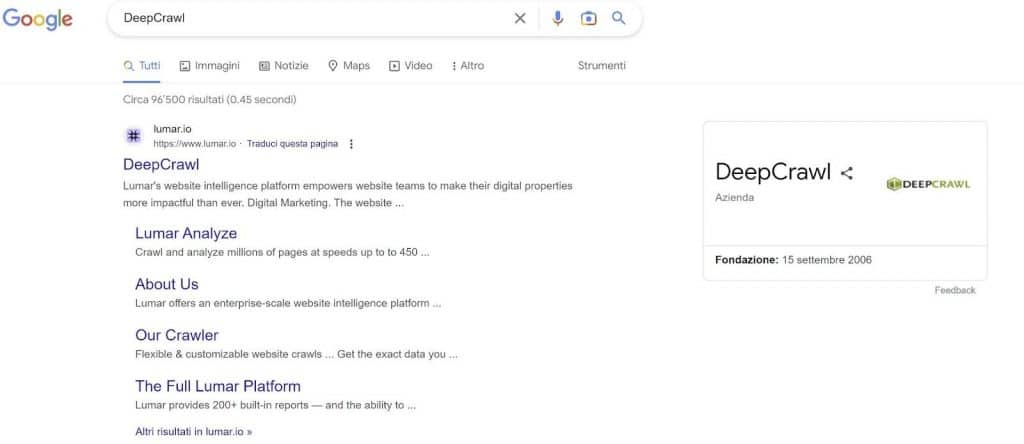
If you are wondering why Google is not giving the Knowledge Panel for Lumar, the answer is very simple – the information Google has is not clear and consistent, because at the end of the day, it’s still a machine. A smart machine, but a machine nonetheless. Below we have an example of this confusion. We can still find online reviews about DeepCrawl, which by the way is a source of Trustworthiness which is part of EEAT.

EEAT
This is a good time to also introduce the consequences on EEAT (Experience, Expertise, Authoritativeness, and Trustworthiness). If you don’t know what EEAT is and you wish to dive deeper, you can check out Jason’s article on it. To keep it simple, let’s say that these are signals embedded in Google’s algos to help them judge the credibility of the author, the publisher and the content. Positive EEAT signals will ultimately help your content rank, even if EEAT is not a ranking factor per se.
It is much easier for Google to apply signals to something that it understands. We know that everything Google understands becomes an entity and becomes part of the knowledge graph and ultimately (when Google has no doubt), is presented through a Knowledge Panel.
The way that I understand EEAT is as signals that intercede at all levels, starting from the content, up to the author who wrote the info on the blog, up to the website in general and up to the website publisher (Company / Brand).
Connection between EEAT and brand
If you check the Google Search Console (GSC), there is a very high chance that most of the keywords you see there are branded (brand + word). If that’s the case and you see a good correlation between the impressions and the clicks, it probably means that your website is answering your audience’s questions about your brand. This helps the Expertise part of EEAT.
Let’s replicate this logic in terms of the rebranding:
1. Lumar does not have a Knowledge Panel. This means that Google is not certain about it. So when EEAT signals are applied, they are applied without having a complete understanding of the company.
2. It also means that Lumar needs to rework the question they need to answer with regard to their audience. This reworking would create a virtuous circle because Google would better understand it and, at the same time, it would help the EEAT signal, especially Expertise.
My prediction is that if Lumar doesn’t correct the information soon, it will start to have its own Knowledge Panel distinct from DeepCrawl. This means there will be two Knowledge Panels, one for DeepCrawl and one for Lumar. In the next session we will see what that means by using the DJO example.
Multiple Knowledge Panels
As with the previous case, we’ll start with an example.
DJO (a medical device company) became DJO Global. Next it was acquired by Colfax and ultimately became Enovis in 2022. Its most well-known product is Compex. If you’ve ever been in sport then you’ll likely know what Compex is.
Let’s confirm the information I’ve given above. As you can see from the image below (image 2: DJO is now Enovis), the first piece of information we get on the DJO Global website is that DJO is now Enovis.

The first thing that we notice is that DJO did not redirect the website to Enovis’ website. It has been left open with some very basic information but no products.
An interesting piece of information that confirms that DJO was rebranded as Enovis is that the DJO stock symbol (NYSE:DJO) no longer exists and we are instead redirected to the ticker NYSE:ENOV (Image 3: NYSE:DJO).
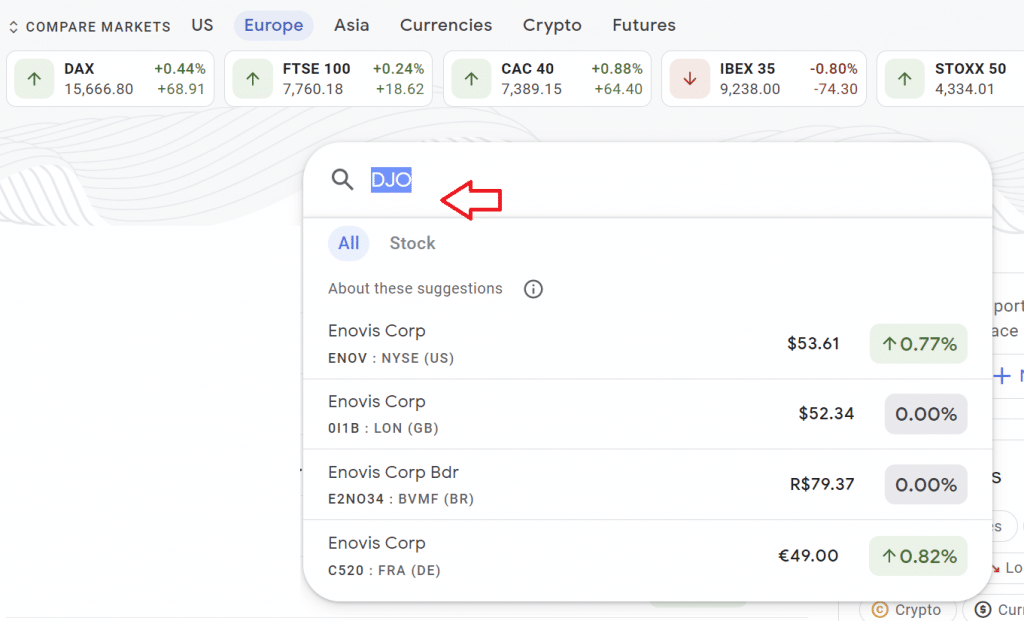
Now, let’s enter “DJO” into Google. As you can see from the image (image 4: DJO on Google) below, there are 2 Knowledge Panels. Remember each Knowledge Panel also has a different KGMID.

If we select the Knowledge Panel DJO Global, we can see from the image (image 4: DJO Global) below that we have a lot of information, but what stands out most is that Enovis is the parent company. This means that Google updated the Knowledge Panel. As a result, instead of having a Knowledge Panel with written Enovis we have a DJO Knowledge Panel with an updated information.
Let’s go a step further and analyze the DJO Global Inc. (see: image 6: DJO Global Inc. ) Knowledge Panel (the second one available on Google with the query “DJO”).
As with the previous Knowledge Panel, we have a Parent organization. This time it’s stated that Enovis and DJO Finance LLC are the parent organization. However, it’s stated on their website that DJO is now Enovis. Once again, I find it very curious that Google updated the information on the DJO Global, Inc. Knowledge Panel instead of updating the Knowledge Panel with the name Enovis.
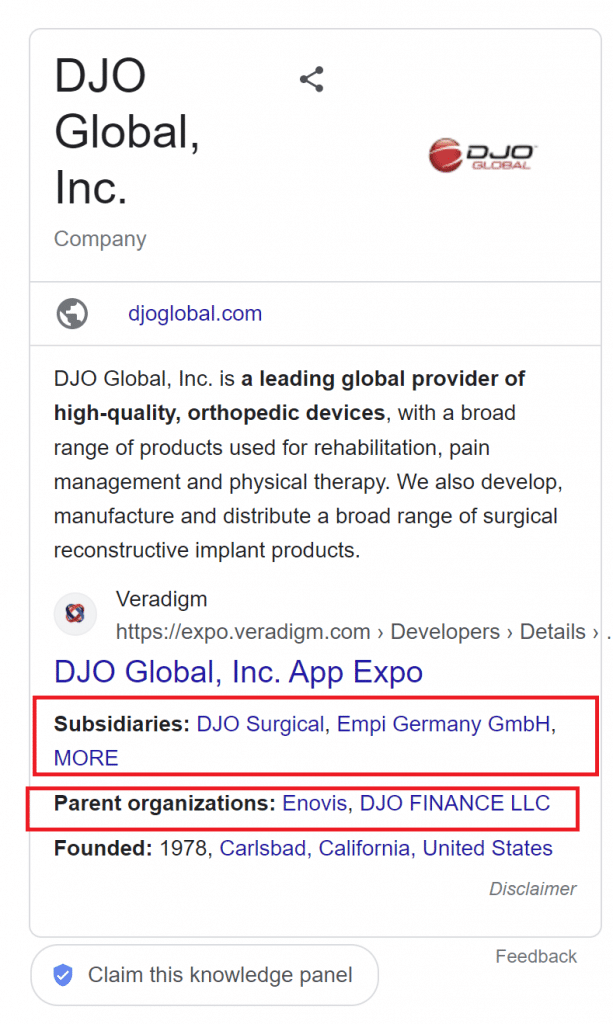
So the question is: where did Google take the information about the parent organization from?
Taking into account that DJO should now be Enovis. There is no direct information about the parent company on the web. However, we can suppose that Google’s assimilation of ideas was:
- Colfax is DJO the parent company. Colfax acquired DJO in 2019 and this information is published all over the web
- Colfax became Enovis. Another piece of information available all over the web
- Enovis is the parent company of DJO
This misunderstanding (Google updating the Knowledge Panel) is the result of inconsistent and fragmented information found on the web.
Let’s go one step further and analyze the former Colfax corporation, now Enovis (image 7: Colfax ) . This rebranding was a success. Colfax corporation was rebranded as Enovis and there is no longer a Colfax Knowledge Panel, but instead an Enovis Knowledge Panel (see image below). Moreover, the website is Enovis.
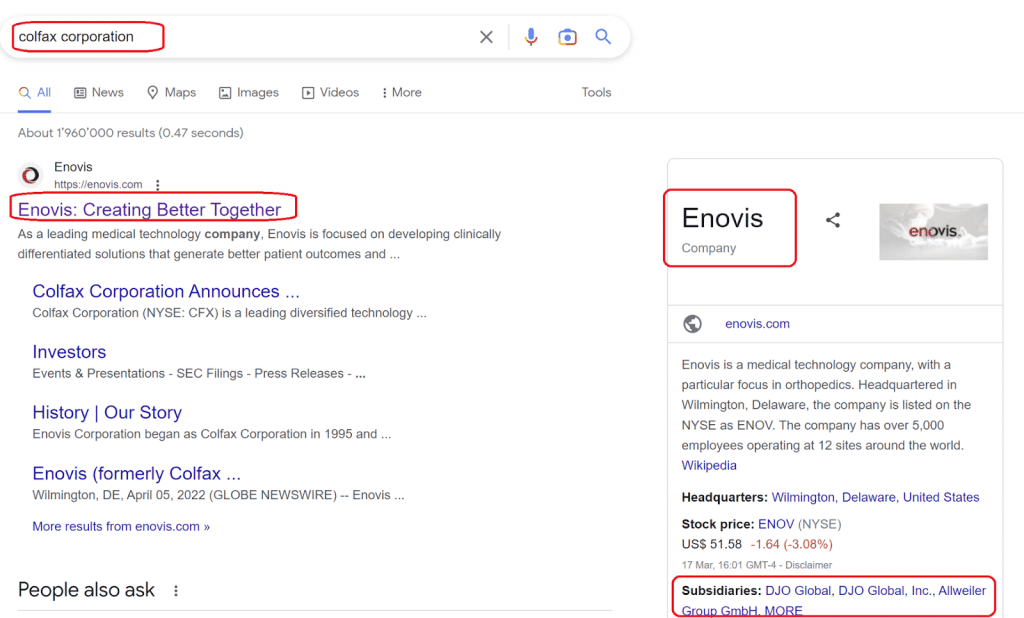
To sum up, let’s analyze the repercussions for DJO:
1. Google did not correctly understand (or was not sure) about the connection between the old and new company (DJO and Enovis). As a result, there are 2 Knowledge Panels for DJO Global + 1 for Enovis. How confusing is that! The implication of this all is that we end up with 1 company but 3 different SERP for the same company.
3. Coming back to EEAT, we have more than 3 KGMID (in the example we used 3 Knowledge Panels but actually there are more for DJO) for the same company and as a result according to Jason Barnard, we will have duplicated Knowledge Panel – and a duplicated Knowledge Panel will split any “Entity Equity”. As a result, soE-E-A-T signals will be dampened / reduced. This was demonstrated in the case study Jason Hennessey where it was shown how merging entities brings better understanding.
In the next session, we will look at the challenges that DJO (now Envois) and DeepCrawl (now Lumar) faced. Those challenges could explain why their rebranding was not done correctly.
Challenge 1: Accumulate the Relevant Information
Preparing for a rebranding is very challenging because you need to list all URLs ranking for the brand/branded words and for each URL you need to know where your brand was used. This could imply title tags, meta description (even if it’s not a ranking factor you still want to change it for your user), schema mark up, Headings, content and ALT text.
Some of those URLs will be more important than others. For instance, for a podcast you will need for sure to change the podcast website homepage, the platform where the podcast is hosted (Apple, Spotify, etc.), and the relevant sources. This means going through the SERP and preparing a list of URLs and the information previously referred to.
While this could appear to be a simple task, it’s extremely time consuming. Even taking into account a simple example, such as rebranding the podcast, you will need to update between 30-40 sources. Allyssa (the Kalicube Pro team lead) decided to try this exercise and do it manually – it took her 12 hours to accumulate a list of 40 URLs.
Now, imagine if your brand is Nike. Nike has hundreds of branded words which are also entities. For instance, Nike Jordans, Nike Air Max, etc. Now, for each of those related words/entities we need to conduct the same exercise and accumulate a complete list of URLs and valuable info for each URL that needs to be updated. You can easily guess the number of hours that would require if it takes 12 hours for 30-40 URLs.
This could partially explain why neither DeepCrawl/ Lumar nor DJO/Enovis succeeded completely.
One of the solutions is to use Kalicube Pro to speed up the process (more of that later).
Challenge 2: Coordinating the Changes
Once you have the list of URLs, that’s half the job done. Next you need to implement the changes, but the changes need to be done all on the day of the go-live. That implies a lot of coordination in the background to make sure that on the day itself, the changes happen. Everything needs to be planned down to the smallest detail.
A good success story is Facebook, which rebranded as Meta. They prepared months in advance but kept it all hidden.
They changed everything in just a few hours:
- New site
- Name change in all metas and titles on all pages they control
- Name change on social media profiles
- Changed Wikipedia, Wikidata, Crunchbase and other data sources
Here you can find Jason Barnard analysis on Facebook’s rebranding. As you can see from the video, in just a few hours the SERP started adapting the information.
We’ve accumulated quite a bit of knowledge so far – we have seen the different case scenarios and understood why things didn’t work like a charm for some brands. Now, let’s take a look at how Jason Barnard did it so that brands can reproduce the steps and hopefully achieve the same success.
However, let’s first analyze some interesting facts about the rebranding from “With Jason Barnard” to “Branded Search (and Beyond)”.
The particularly interesting facts about this rebranding are:
- Jason was able to keep the same kgmid for the rebranded podcast: https://www.google.com/search?kgmid=/g/11frbnpw_7. This means just one brand and one Knowledge Panel.
- Google updated the knowledge graph in just 2 days. As a comparison, normally a change to the Knowledge Panel takes 3 months or more depending on the complexity.
How Jason Barnard Made a Success of the Podcast Rebranding
Let’s analyze the steps:
Step 1: Choice of a name that makes sense to humans…but to a machine too
To understand the choice of name or sentence that Jason used, we need to introduce the semantic triple concept. To understand this, let’s go back to Leonardo da Vinci.
If we say “Leonardo da Vinci is a scientist” we have a semantic triple.
This triple can be broken down like this:
Subject: Leonardo da Vinci
Predicate: is a
Object: scientist
This is a sentence that helps computer understanding by connecting entities together through the predicted expression. That means that the predict explains the relationship between the entities
We can take the understanding one step further
If we say:
“Leonardo da Vinci was born in Anchiano”
“Anchiano is part of Italy”
= that is to say Leonardo da Vinci comes from Italy
This is how Google’s Knowledge Graph works. So the fondation is the semantic triple and thanks to that, it’s possible to connect all the entities within an overall logic.
Coming back to Jason Barnard, he changed his podcast name from With Jason Barnard to Branded Search (and Beyond) with Jason Barnard.
There was consequently an improvement in the triple semantic. The title With Jason Barnard was missing the subject. With the new title, we have the triple semantic:
Branded Search (and Beyond) with Jason Barnard
It’s interesting to note that the words and parentheses used “(and Beyond)” are used to provide additional information about Branded Search. So it doesn’t change the basic structure of the sentence or the semantic triple.
Step 2: Find the corroborate sources
We already introduced this point while talking about Lumar and Nike. It is crucial to find the list of URLs & the information that needs to be updated. Below is an example of the file you need to construct to prepare for the information change. In my case, I just downloaded them with Kalicube Pro.
I personally find 3 advantages to using Kalicube Pro:
1. It takes me a second to download a list with Kalicube Pro that otherwise takes hours/days to construct.
2. I obtained a list ranked by importance. That means that I can quickly identify what to change first.
3. Taking the test done by Allyssa, it’s possible to see that the tool also obtains about 40% more references than a manual check.
Step 3: Orchestrate the changes in advance
Having all the above information is of no benefit if brands don’t act. They need to organize everything in advance and change the information in a few hours after the go-live. It’s clear that it’s not possible to improvise given that everything needs to change as fast as possible. Just take the case study we looked at before with the change from Facebook to Meta. This is exactly what Jason and team did before the go-live. Contacted who needed to be contacted and prepared all access to websites they could control.
Step 4: Go-live
The go-live date has arrived. As the name changed, they ensured all required redirects on the podcast website first of all. Next, they changed all the sources based on the list they had.
The Rebrand Only Took Two Days to Take Effect
Once everything was organized, there was not much left to do other than give Google time to absorb the news. What was spectacular is that the Knowledge Panel was updated in just 2 days, whereas it normally takes 3 months
Let’s look at the before and after
Before:
After:
The Main Three Wins Are:
1. Google understood the brand change. This is clearly a big achievement!
2. Google was able to recognize the rebranding and keep the same KGMID because, as we have seen with the DeepCrawl and DJO examples (to refresh your memory see image 11 DJO/ image 12 DeepCrawl), it’s very common to have two Knowledge Panels, or worse, to lose the Knowledge Panel as a result of the rebranding.


3. The last main accomplishment, and certainly not the least, is that the change became effective in the space of just 2 days, instead of the usual 3-month cycle.
Rebranding is a Lot of Work
Rebranding is a lot of work, and that workload increases with the size of the company/project. Which means that, for small projects, it can still be done manually.
However, for medium/large companies/projects, it quickly becomes a herculean task. It’s extremely important to gather all online sources and information needed before
starting the rebranding process, as these need to be updated in a short space of time (ideally a few hours) from the rebranding go-live.
If you choose not to do so, there is a high risk of having several Knowledge Panels, or (even worse) losing the Knowledge Panel. Moreover, it is important to keep an eye on the SERP to make sure that Google has understood the updated information.
Consequently, for medium and large companies/projects, it’s important to use the correct tools. This will make the rebranding simpler.
As shown in the case study, using Kalicube Pro can help by extrapolating all sources and information needed in just a few minutes instead of hours/days. What’s more, it can help in tracking the SERP (Search Engine Result Page), which will certainly help keep you on track to ensure that the rebranding process goes smoothly.
Do you need help with rebranding? We can support you. Come talk to us!
